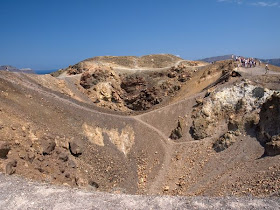Scientific Minds Want To Know - Greek Edition
A new study of insect pests found in
an ancient storage jar on the Greek island of Santorini suggests the
major volcanic eruption that took place there around 1600 B.C.—and which
may have inspired the legend of Atlantis—happened in early summer. |
| The volcanic crater on Nea Kameni in Santorini, Greece [Credit: Celyn, Alamy] |
Based on previous evidence, scientists had concluded that the eruption happened sometime between 1627 to 1600 B.C. But there has been one important and unresolved question about the event: What season did it take place in?
In a new study, published in a recent issue of the journal Naturwissenschaften, Panagiotakopulu and her team now say that based on insect remains found in a jar containing seeds of sweet peas discovered at the Bronze Age settlement of Akrotiri, they think the eruption occurred sometime between June to early July.
It was only during these months, the scientists say, that the insect, a species of bean weevil, would have had an opportunity to infest the crops and end up in the storage area.
"There is a short window from early to mid summer just after threshing which could justify the assemblage [of insects] recovered," Panagiotakopulu explained in an email.
What's New?
Often called the "Pompei of the Aegean world," Akrotiri was buried in a layer of ash and pumice during the eruption that helped preserve the site for thousands of years.
"The infested [peas] were found in one of the ground-floor rooms of the West house"—a multistory building in the northwest section of the city—"which was used for storage," Panagiotakopulu said.
Even though the seed jar and its cache of insects was found about 50 years ago, it wasn't until recently, following the development of better techniques to date fossil insect material, that scientists realized they could be used to help date the eruption that buried the city.
"The idea came much later," Panagiotakopulu said, and was "the outcome of long-term study on fossil insect on this and other sites."
Using a new pretreatment method to radiocarbon date a protein called chitin that makes up the insects' shells, the researchers obtained a date range (1744 to 1538 B.C.) for the fossils that agreed with the findings from other studies.
More importantly, though, the scientists realized the insects were their best clue yet about what season the eruption took place in.
Why Is It Important?
Determining the year that a prehistoric volcanic eruption took place is notoriously difficult, Panagiotakopulu explained, and trying to assign a season to one is even harder.
Other researchers have tried to figure out the season of the Santorini eruption by analyzing the distribution of its ash and debris.
"But in our case, we are speaking from the site data," Panagiotakopulu said. "How often can one go back to a prehistoric event and say that it happened during summer?"
What Does This Mean?
The bean weevils found in the jar of sweet peas at Akrotiri were at different stages of their life cycles. The fossil assemblage included larvae, pupae, and adults or "imagines."
This is important, the scientists say, because it suggests the insects were killed as a result of a single event, probably shortly after the seeds were stored away.
"The [beetles] found can only infest [peas] in the field and they have one annual life cycle," Panagiotakopulu said.
Knowing the season of the Santorini eruption could allow scientists to create more accurate models of the event and lead to a better understanding of how the ash and debris was scattered around the globe, she added.
What's Next?
Panagiotakopulu said there are other seed assemblages at Akrotiri that warrant further study.
"More work on relevant deposits," she said, "closely dated by historical or archaeological context on other sites will enable the refinement of the methodology for dating insect chitin and allow its wider application."

No comments:
Post a Comment